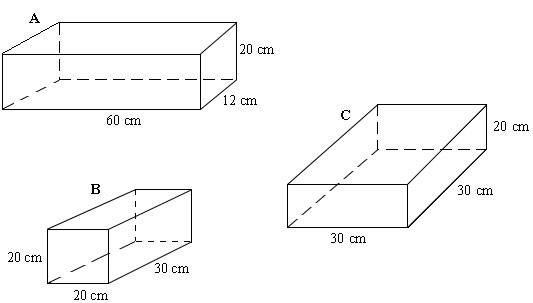Cuboid fish tanks
This task is about working out the volume of different cuboids given the height, length and width.

| a) |
Find the volumes of the fish tanks marked A, B, and C.
|
|
Tank A: ____________ cm3 Tank B: ____________ cm3 Tank C: ____________ cm3
|
|
| b) |
How many millilitres of water would each of the three tanks hold?
|
|
Tank A: ___________ ml Tank B: ___________ ml Tank C: ___________ ml
|
| c) | i) |
Which two tanks could be filled to the top from a bucket holding 29 litres of water without overflowing?
Tanks __________ and __________
|
| ii) |
Providing there were no spills, how much water would be left in the bucket after the two tanks had been filled?
_______________
|
| d) | i) | If the volume of water from each tank was tipped into a bigger bucket that weighed 1 kg when empty, what would this bucket weigh with all the water in it? |
| (A) | Less than 50 kg | ||
| (B) | Between 51 kg and 60 kg | ||
| (C) | Between 61 kg and 70 kg | ||
| (D) |
More than 70 kg |
||
| ii) |
Explain how you worked out your answer. Show your working.
|
||

